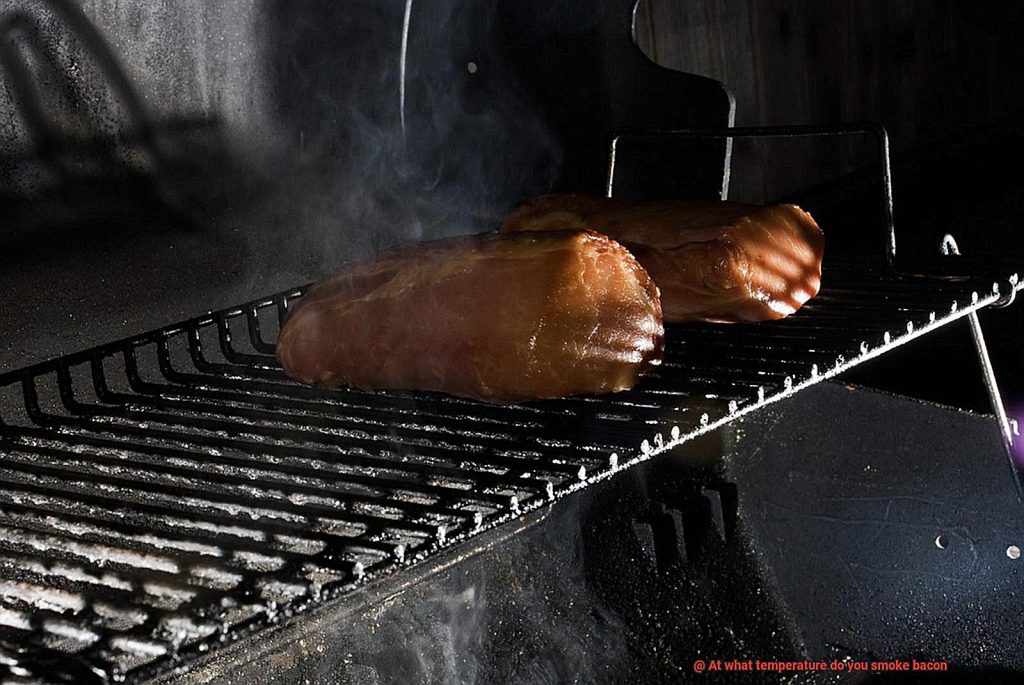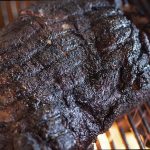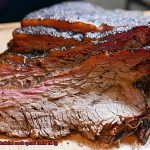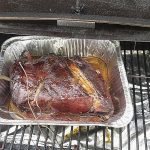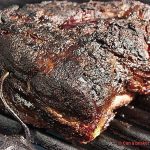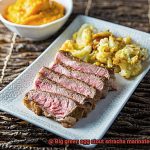Contents
Calling all bacon enthusiasts and culinary adventurers.
Are you ready to embark on a smoky, sizzling journey into the world of smoked bacon? Imagine the tantalizing aroma of perfectly smoked strips of bacon, each bite bursting with flavor and melt-in-your-mouth goodness.
Whether you’re a seasoned pitmaster or just a curious bacon lover, mastering the art of smoking bacon is like unlocking a secret treasure chest of taste sensations. But fear not, my fellow foodies, because we’re about to reveal the temperature sweet spot that will take your bacon game to new heights.
Get ready for a mouthwatering adventure that will leave you craving more crispy, smoky goodness.
What is the Ideal Temperature for Smoking Bacon?
Imagine a lazy Sunday morning, the sun shining, and the delectable aroma of sizzling bacon wafting through the air. Now, envision taking that bacon to new heights of deliciousness by infusing it with a rich, smoky flavor. We’re talking about the art of smoking bacon. But what temperature should be used to achieve the perfect balance of tenderness and smokiness? Join us on a flavorful journey as we explore the secrets behind the ideal temperature for smoking bacon.
The Low and Slow Approach:
In the realm of smoking bacon, slow and steady is the name of the game. The ideal temperature range for smoking bacon falls between 200°F (93°C) and 225°F (107°C). This gentle cooking method allows the bacon to absorb the smoky flavors while retaining its juiciness and tenderness. Picture each slice enveloped in a cozy blanket of smoky love.
Consistency is Key:
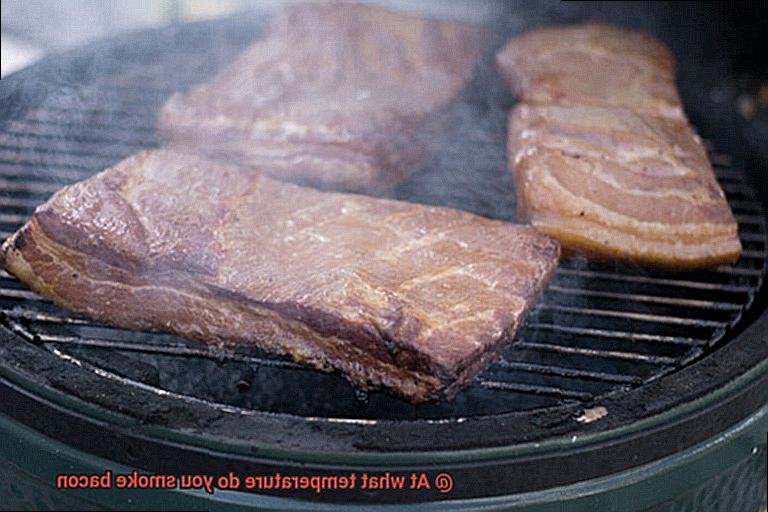
When it comes to smoking bacon, consistency is crucial. Imagine biting into a slice that’s perfectly smoked on one end but still raw on the other – not quite the experience we’re looking for, right? To ensure even cooking and flavor distribution, it’s important to maintain a consistent temperature throughout the smoking process.
Preheat for Success:
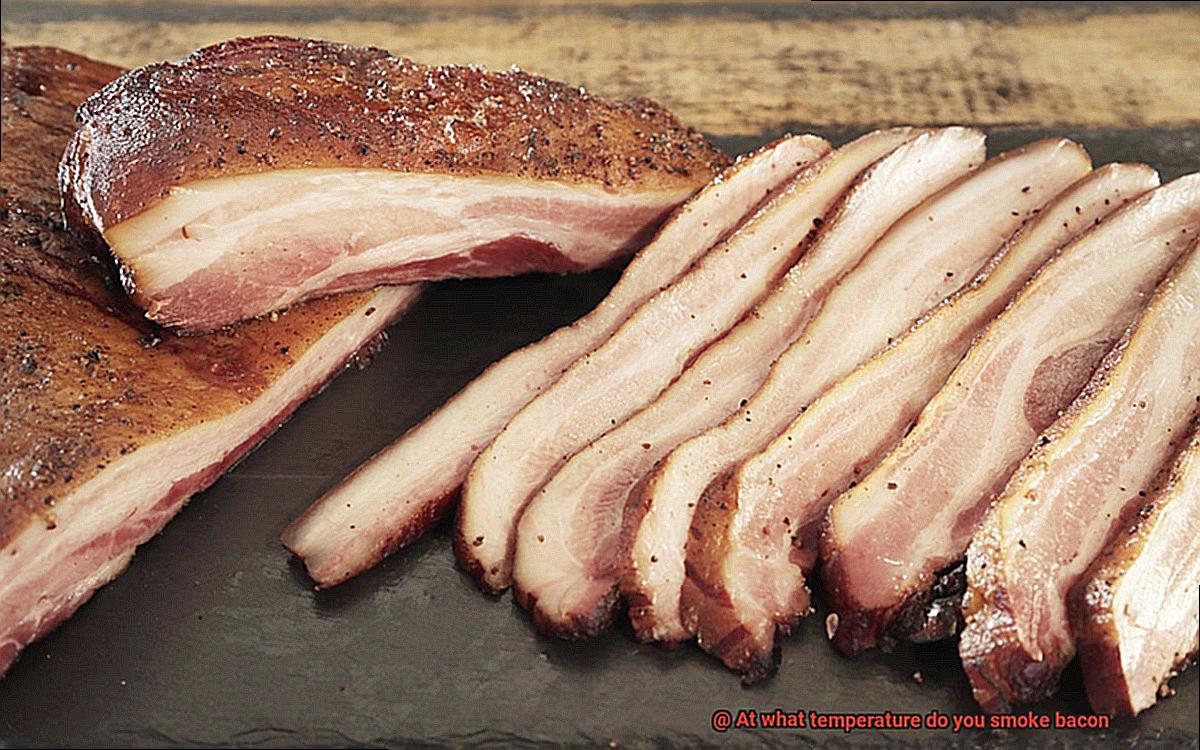
Before embarking on your bacon-smoking journey, ensure your smoker or grill is preheated to the desired temperature. This guarantees a stable cooking environment from the start. Remember, we want that bacon to be enveloped in a cloud of smoky goodness right from the beginning.
Wood Choice Matters:
To elevate the smoky flavor of your bacon, consider using wood chunks or chips such as applewood, hickory, or maple. Soak them in water for about 30 minutes before adding them to the smoker to generate a steady stream of flavorful smoke. Each bite will transport your taste buds to a savory wonderland.
Timing is Everything:
The smoking time for bacon can vary depending on its thickness and your desired level of smokiness. On average, it takes around 2-3 hours to smoke bacon to perfection. Remember to rotate and flip the bacon occasionally during the smoking process to ensure even cooking and prevent any unsightly sticking. Patience will be rewarded with bacon bliss.
Safety First:
It’s important to note that the internal temperature of your smoked bacon should reach a minimum of 145°F (63°C) to ensure it is safe to consume. However, some prefer their bacon slightly crispier and may continue smoking until an internal temperature of 160°F (71°C) is reached. Use a meat thermometer to check for doneness by inserting it into the thickest part of the bacon slices. Your taste buds and health will thank you.
Preheating Your Smoker Before Adding the Bacon
Now, we’ll be delving into the world of smoking bacon. But before we dive in, there’s one essential step you must not overlook: preheating your smoker. This simple yet crucial step is the key to achieving that perfect balance of flavor and tenderness in your bacon.
So why is preheating so important? Let me break it down for you. When you preheat your smoker, you’re ensuring that it reaches the optimal temperature for smoking bacon. We’re talking about a range of 200°F to 225°F (93°C and 107°C), where the magic happens. This low and slow cooking method allows the bacon to slowly absorb those smoky flavors while retaining all its juicy tenderness. Isn’t that what we’re all after?
Now, let’s get into the nitty-gritty of preheating. First things first, give your smoker a good cleaning. You want to start with a fresh slate and avoid any unwanted flavors from previous grilling sessions. Once that’s done, fill up the water pan with hot water. This little trick helps regulate the temperature inside the smoker and creates a moist environment that keeps your bacon from drying out.
Now comes the fun part. Set the temperature control of your smoker to that sweet spot of 200°F to 225°F and let it preheat for at least 15 to 30 minutes. This gives your smoker enough time to reach a stable temperature throughout. And remember, always keep an eye on that thermometer. Accuracy is key when it comes to maintaining a consistent heat.
Once your smoker is heated and ready, it’s time to bring on the bacon. Arrange those slices in a single layer on a wire rack or directly on the smoker grates, allowing that delicious smoke to circulate evenly around each piece. And here’s a pro tip: try to keep that smoker door closed as much as possible during the smoking process. We don’t want any unnecessary heat fluctuations or extended cooking times, do we?
Now, here’s the important part for all you food safety enthusiasts out there. Smoking bacon typically takes around 2 to 3 hours, depending on the thickness of your slices and how crispy you like it. But always, always check the internal temperature with a meat thermometer. We’re looking for at least 145°F (63°C) to ensure our bacon is safe to devour.
Once your bacon has reached its desired internal temperature, give it a little rest before serving. This allows the juices to redistribute, resulting in an even more flavorful and tender bacon experience. Trust me, it’s worth the wait.
Monitoring the Temperature Throughout the Smoking Process
In this guide, we will delve into the meticulous art of monitoring the temperature throughout the smoking process to ensure your bacon is cooked to succulent, smoky perfection. So, don your apron and join us on this mouthwatering adventure.
Preparation is Key:
Before you embark on your bacon journey, it’s crucial to prepare your smoker for the ultimate flavor infusion. Thoroughly clean your smoker, creating a fresh canvas for your bacon masterpiece. Fill the water pan with hot water to create a moist environment that keeps your bacon juicy. Set the temperature control just right and let your smoker preheat for 15 to 30 minutes. This preheating process ensures every inch of your smoker reaches a stable temperature, allowing your bacon to luxuriate in smoky goodness.
The Perfect Temperature Zone:
Your bacon deserves nothing but the best, which means maintaining a consistent temperature between 200°F and 225°F (93°C and 107°C). This temperature range allows the flavors of wood smoke to permeate the meat, creating a symphony of smoky deliciousness.
Monitoring Made Simple:
To keep an eye on that perfect temperature, equip yourself with a reliable thermometer. Place a probe thermometer into the thickest part of the bacon, ensuring it avoids any bone or fat for accurate readings of the bacon’s internal temperature.
Safe and Savory:
While personal preferences may vary, prioritize food safety. The recommended internal temperature for smoked bacon is 145°F (63°C). For crispy bacon lovers, aim for an internal temperature around 160°F (71°C). If a softer texture is more to your liking, target an internal temperature of approximately 145°F (63°C). Remember, it’s all about finding the perfect balance between safety and taste.
The Waiting Game:
Smoking bacon is a slow and tantalizing process that demands patience. It may take several hours for your bacon to reach its desired internal temperature. Throughout this journey, keep an eye on the thermometer and adjust the heat source as needed to maintain the desired temperature range. Remember, perfection takes time.
Starting with a Higher Temperature to Render Fat
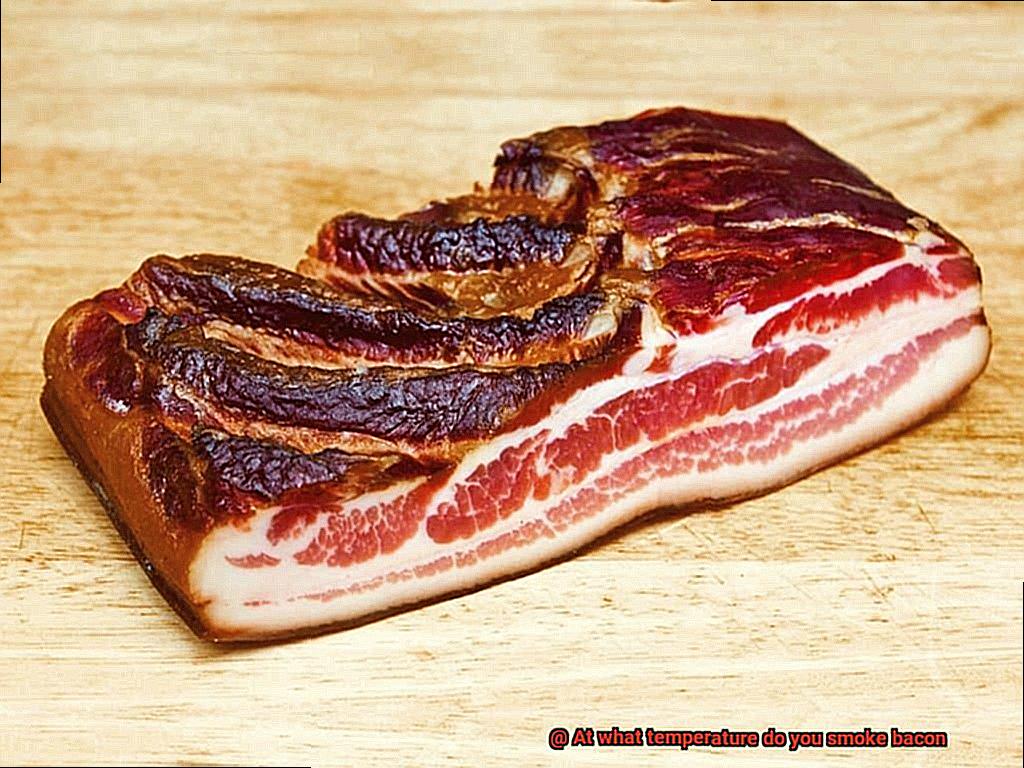
Today, we embark on a tantalizing journey through the smoky realms of bacon, unraveling the secrets to achieving that perfectly crispy and irresistible texture. Prepare to elevate your grilling game and ascend to legendary status as a bacon connoisseur.
So, why should you start with a higher temperature when rendering fat in bacon? Let’s delve into the mouthwatering details:
- Mastering the Art of Fat Rendering: The key to unlocking bacon nirvana lies in rendering the fat. By starting with a higher temperature, the fat liquefies, making it effortlessly drain away. Say goodbye to greasy excess and hello to a heavenly eating experience.
- The Goldilocks Zone: To render fat effectively, you must find that sweet spot between 325°F (163°C) and 350°F (177°C). Within this range, the fat melts swiftly, creating a delectably crisp exterior while ensuring thorough cooking throughout.
- A Grease-Free Extravaganza: Beginning with a higher temperature guarantees complete fat rendering. Lower temperatures risk leaving you with bacon drenched in unwanted grease, lacking the desired crunchiness. Nobody wants their plate to resemble an oil slick.
- Avoiding Incineration: However, beware of cranking up the heat too high. Excessive temperatures can lead to burnt or excessively crispy bacon before the fat has had ample time to render. Achieving that delicate balance is paramount for bacon perfection.
To help you master this culinary art form, here are some invaluable tips and tricks:
- Harness the Power of Thermometers: Invest in a reliable thermometer to accurately gauge the temperature within your smoker or grill. This ensures you stay within the ideal range throughout the cooking process.
- Taming the Flames: Create a controlled environment by setting up a two-zone fire or utilizing indirect heat. This prevents flare-ups and hot spots that could scorch your bacon masterpiece.
- Preheating like a Pro: Before introducing the bacon, preheat your smoker or grill to the desired temperature. This guarantees even cooking and wards off any unwelcome surprises.
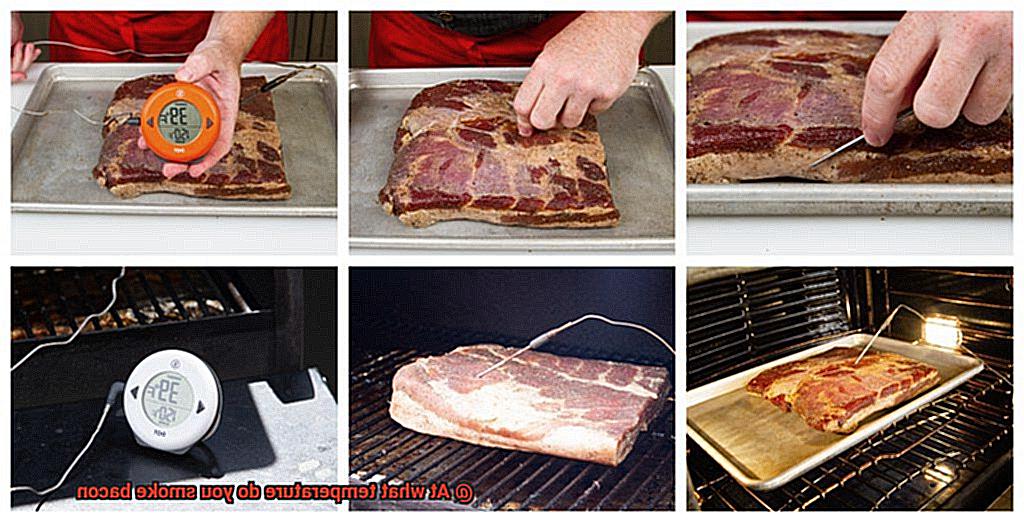
There you have it, grilling gurus. Starting with a higher temperature when smoking bacon is the secret ingredient to achieving that tantalizingly crispy texture we all crave. Remember to find that sweet spot between 325°F and 350°F, monitor your cooking process closely, and prepare to be amazed by the oh-so-satisfying results.
The Total Smoking Time for Bacon
When it comes to smoking bacon, the total smoking time is influenced by several factors that can make or break your culinary masterpiece. Let’s dive into the smoky realm of bacon and explore these crucial elements that determine the perfect duration for achieving that mouthwatering flavor.
Thickness matters. Whether you prefer thick, meaty slices or thin, delicate strips, the thickness of your bacon directly affects the smoking time. Thicker cuts require more time in the smoker to allow the flavors to penetrate deep into the meat, while thinner slices require less time for a quicker and lighter smokiness. It’s a delicate dance between thickness and intensity.
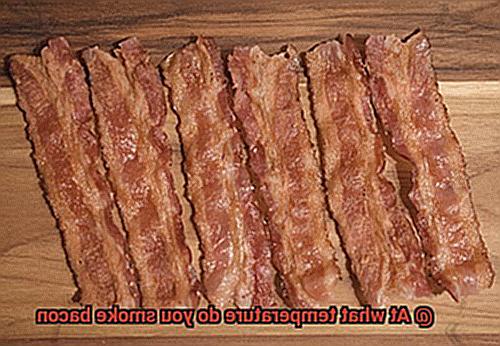
Crispiness is a personal preference that can’t be ignored. Some crave a soft and tender texture while others yearn for that satisfying crunch. If you lean towards the softer side, a shorter smoking time will do the trick. But if you desire that divine crispiness, be prepared to let your bacon sway in the smoker for a bit longer, absorbing all the smoky goodness.
The type of smoker you choose also plays a significant role in determining the total smoking time. Each smoker has its own unique temperature range and heat distribution capabilities, so it’s important to familiarize yourself with your specific equipment. Mastering your smoker’s settings will help you achieve that perfect balance of flavor and texture. Aim for a low temperature between 200-225°F (93-107°C) to unlock the secret to bacon nirvana.
Monitoring the internal temperature of your bacon is essential for both safety and taste. To ensure your bacon reaches a safe internal temperature of 145°F (63°C), use a reliable meat thermometer throughout the smoking process. Some smokers come equipped with built-in thermometers or temperature control features, making it easier to maintain a consistent heat. Don’t leave this crucial step to chance.
To achieve even cooking and avoid any burnt or overly crispy spots, don’t forget to rotate your bacon slices occasionally. This simple act of love ensures that every inch is kissed by the smoky embrace, resulting in a picture-perfect bacon experience.
Now let’s talk personal preference. Are you a fan of a milder smoky flavor, or do you crave that intense, robust smokiness that envelops your taste buds? The smoking time can be adjusted accordingly to cater to your desires. A shorter smoking time will grant you a subtle and delicate taste, while a longer duration will unleash a bold, in-your-face smokiness that demands attention.
But hold on. Safety should always be your top priority. Follow proper food safety guidelines, maintain good hygiene practices, and don’t compromise on cleanliness while smoking bacon. We’re here for the smoky goodness, not the unwelcome surprises.
Ensuring the Bacon Reaches a Safe Internal Temperature
This breakfast staple is a crispy delight that tantalizes our taste buds. But to truly enjoy this savory treat, we must ensure it reaches a safe internal temperature. In this article, we will explore the key steps to guaranteeing your bacon reaches a safe internal temperature of 145°F (63°C) while maintaining its desirable texture and flavor.
The Importance of Internal Temperature:
Cooking bacon to the recommended internal temperature is crucial for food safety. According to USDA guidelines, bacon should reach a minimum internal temperature of 145°F (63°C). This ensures that any potential harmful bacteria, like salmonella or E. coli, are eliminated, providing peace of mind and a mouthwatering meal.
Measuring Internal Temperature:
To accurately determine the internal temperature of your bacon, you’ll need a trusty meat thermometer. Insert it into the thickest part of the bacon, avoiding contact with the pan or skillet. Don’t forget to check multiple pieces for accuracy.
Carryover Cooking:
Bacon has a little secret – carryover cooking. Even after removing it from the heat source, the temperature continues to rise. To account for this, take your bacon off when it reaches around 140°F (60°C). By the time it’s served, it will have reached the safe minimum internal temperature of 145°F (63°C).
Balancing Texture and Safety:
Finding the perfect balance between achieving a safe internal temperature and maintaining a desirable texture is key. Overcooking can result in dry and overly crispy bacon, while undercooking poses health risks. Aim for golden brown perfection – no pink or translucent areas.
Different Cooking Methods:
There’s more than one way to cook bacon. Different methods require slight adjustments in time and temperature. Smoking bacon, for example, calls for temperatures between 200°F (93°C) and 225°F (107°C) until it reaches the safe internal temperature of 145°F (63°C). This low and slow approach enhances flavor while ensuring safety.
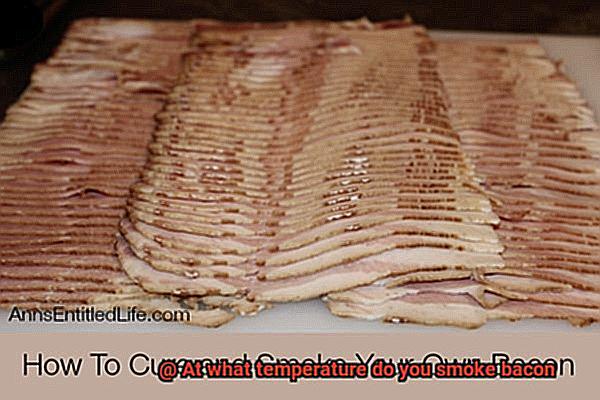
Specialty Bacon:
If you’re cooking specialty bacon, like uncured or nitrate-free varieties, follow the manufacturer’s instructions for cooking temperature and time. These guidelines may differ from regular cured bacon.
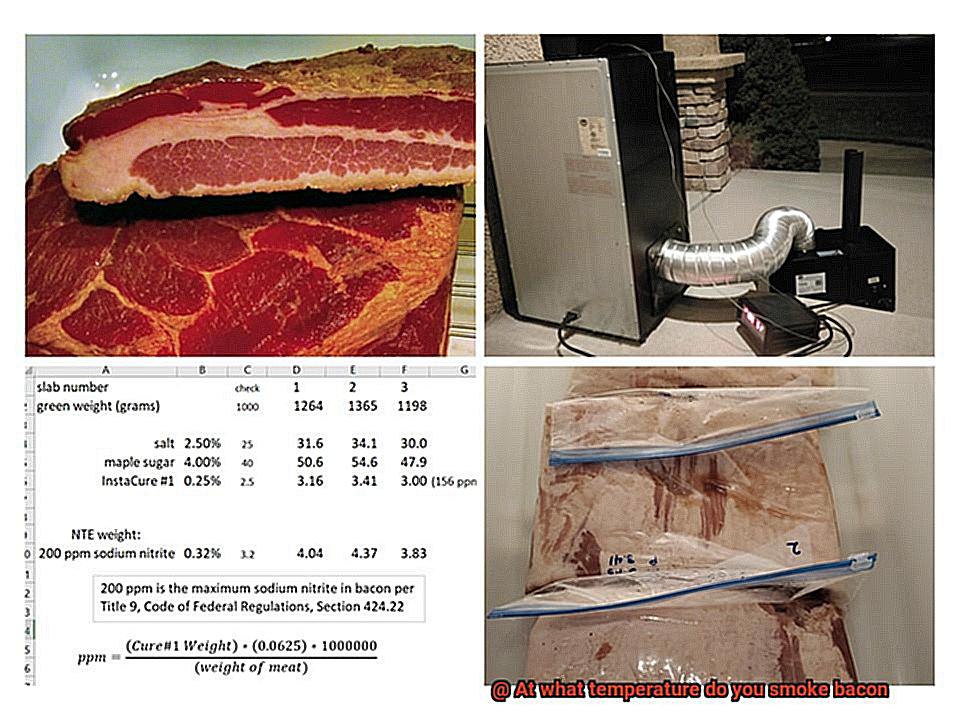
Letting the Bacon Rest Before Slicing and Serving
Get ready to unlock the secret to achieving that perfect crispy-yet-tender bacon glory. We’re about to delve into the importance of letting bacon rest before slicing and serving, a simple step that will elevate your bacon experience from good to mind-blowing. So grab your apron, because we’re about to dive into the juicy details.
Bacon Handling Made Easy:
Imagine this: you’ve just grilled a batch of mouthwatering bacon, and you can’t wait to dig in. But hold your horses. Letting your bacon rest for a few minutes allows it to cool down slightly, making it much easier to handle and slice without burning your fingertips. Safety first, my friends.
Tenderize and Cook Evenly:
Resting your bacon after grilling allows it to continue cooking internally as it retains heat. This means those delicious strips of goodness will be more evenly cooked, resulting in a tender and oh-so-satisfying bite every time. Say goodbye to chewy or undercooked bacon forever.
Flavor Fusion:
Ah, the magic of flavor development. During the resting period, the flavors of your perfectly grilled bacon intensify and meld together, creating a symphony for your taste buds. It’s like a party in your mouth. Trust me, those extra minutes of patience will be totally worth it when you take that first heavenly bite.
Bye-Bye Grease:
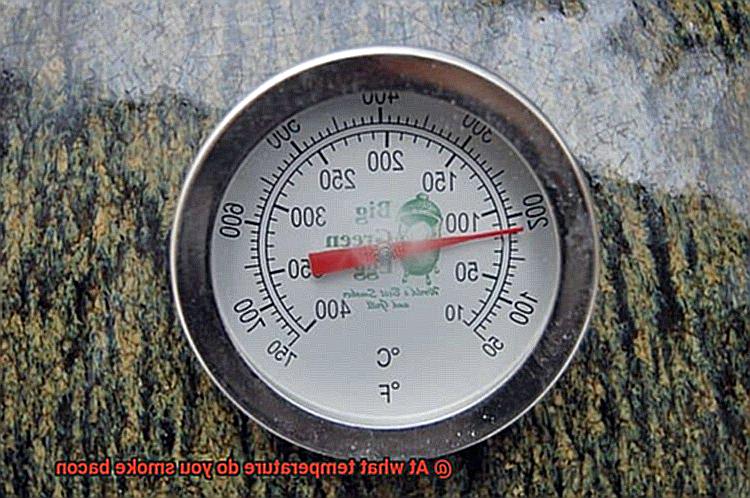
Letting your bacon rest on a wire rack or paper towel-lined plate allows excess grease to gracefully make its exit. Say farewell to greasy messes on your plate and hello to a cleaner, more enjoyable eating experience. It’s truly a win-win situation.
Resting Time:
Now, how long should you let your bacon rest? Well, it depends on personal preference and the thickness of your slices. Generally, a minimum of 5 minutes is recommended, but some grill masters prefer giving it up to 10 minutes. Use this time to whip up some eggs, brew a fresh pot of coffee, or simply bask in the tantalizing aroma of your perfectly grilled bacon.
Enhancing Smoky Flavors with Different Wood Chips or Chunks
We delve into the world of wood chips and chunks and unlock the secret to enhancing the smoky flavors in your bacon. Prepare to tantalize your taste buds with a variety of wood options that will elevate your grilling experience.
Hickory: The Timeless Classic
When it comes to classic smoked flavors, hickory wood reigns supreme. Its bold and robust flavor perfectly complements the rich and fatty nature of bacon. With its subtle hints of sweetness and savory notes, hickory is the go-to choice for traditional bacon lovers.
Applewood: A Delicate Touch
For those seeking a milder smoky flavor, applewood chips or chunks are a must-try. Applewood adds a subtle, slightly fruity aroma that harmonizes with the natural sweetness of bacon. This wood type imparts a delicate touch, perfect for those who appreciate nuanced smoky undertones.
Cherrywood: A Sweet and Fruity Delight
For a unique twist, consider smoking your bacon with cherry wood chips or chunks. Cherrywood offers a delightful blend of sweetness and fruity aroma that enhances the meat’s natural flavors. It provides a mild smokiness that doesn’t overpower the bacon, resulting in a well-balanced flavor profile.
Mesquite: Bold and Robust
If you’re feeling adventurous, mesquite wood chips or chunks deliver an intense smokiness. This wood type offers a bold and robust flavor that can be overpowering if used excessively. However, when used in moderation, mesquite adds a distinctive and earthy taste to your bacon, imparting a unique twist.
Maple: A Subtle Sweetness
Looking to explore new horizons? Consider smoking your bacon with maple wood chips or chunks. Maple adds a subtle and slightly sweet flavor that complements the meat’s natural sweetness. It introduces a touch of complexity to the overall taste, making it an excellent choice for flavor enthusiasts.
0r9B7rvriaw” >
Also Read: How to Season A Blackstone Griddle With Bacon?
Conclusion
When it comes to smoking bacon, the temperature you choose is crucial. It’s the key to achieving that perfect balance of smoky flavor and tender texture. So, what temperature should you aim for? Well, the magic number lies between 200 and 225 degrees Fahrenheit.
At this sweet spot, the bacon absorbs just the right amount of smoke without becoming dry or overcooked. You want those delicious strips to be infused with that irresistible smokiness, but still retain their juicy goodness.
Now, why is this temperature range so ideal? It’s all about slow and steady smoking. By keeping the heat low and consistent, you allow enough time for the flavors to meld together harmoniously. The result? Bacon bliss.
Picture this: thick slices of bacon sizzling on your smoker rack, the tantalizing aroma wafting through the air. As they slowly cook at that precise temperature, each strip transforms into a masterpiece of flavor. The fat renders gently, creating a mouthwatering combination of crispy edges and succulent meat.
So remember, when you embark on your bacon-smoking adventure, set your smoker to a temperature between 200 and 225 degrees Fahrenheit. This will ensure that every bite delivers an explosion of smoky perfection.
In conclusion, smoking bacon is an art form that requires precision and patience. By maintaining a steady temperature within that magical range, you’ll unlock a world of savory delight. So fire up your smoker, grab some quality bacon, and get ready to indulge in a culinary experience like no other.

